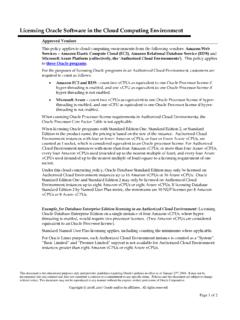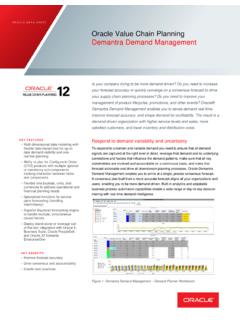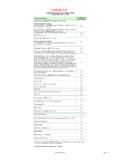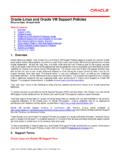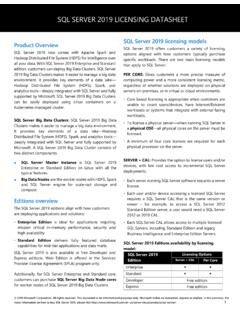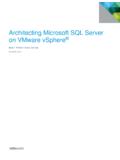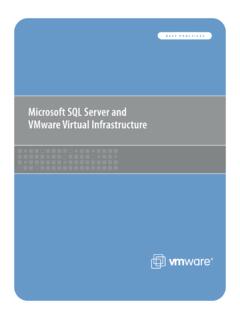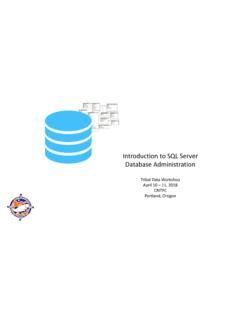Transcription of Connecting Microsoft SQL Server Reporting Services to ...
1 1 Connecting Microsoft SQL Server Reporting Services to oracle Autonomous Database Pedro Torres, Alex Keh This step by step tutorial guides how to configure Microsoft SQL Server Reporting Services (SSRS) connectivity to oracle Autonomous Database (ADB). These instructions use managed oracle Data Provider for .NET ( ) for data access and work for both dedicated and shared infrastructure ADB. Architecture Diagram Provision ADB Download credentials file to SSRS system Install Visual Studio with SSRS Tools Install on the Visual Studio system Configure connectivity Test connectivity SSRS is now configured 2 This document assumes that the Autonomous Data Warehouse (ADW) or Autonomous Transaction Processing (ATP) was provisioned. *Note: Please check here for the oracle documentation to provision ADW. 1. Download the corresponding file to the system that has SSRS installed.
2 These credential files will be used to connect SSRS to ADB. *Note: Also check Downloading Client Credentials (Wallets). 2. Check that SQL Server Data Tools and SQL Server Reporting Services are installed on Visual Studio 2017 or Visual Studio 2019 in the Installed Products window of the About Microsoft Visual Studio dialog. 3 3. Download 32-bit ODAC from the ODAC Xcopy section in the middle of this web page: This procedure guides how to connect Visual Studio SSRS tools to ADB to retrieve data. You will download and enable managed for data access. 4. Unzip the download contents to a staging directory ( c:\xcopy32-install). 5. Open a Windows command prompt *in administrator mode*. Navigate to the staging directory, then execute the next command to install managed : <installation directory> odp32 *Note: Enter the installation location ( c:\odp32) for the directory parameter. 4 6.
3 In the same command prompt with administrator privileges, navigate to the installation subdirectory, <installation directory>\ \bin\4. Then, execute the following command to configure managed on the machine: OraProvCfg /action:config /product:odpm / /providerpath:"../../managed/ " 7. Navigate to where you downloaded the oracle ADB credentials. Unzip the contents to a directory. 5 8. In the Windows environment variables dialog, create the TNS_ADMIN variable and set it to the directory location where you unzipped the ADB credentials. *Note: The net service names will be used to connect to ADB. 9. Modify the file. Change the directory location where the wallet ( ) has been unzipped. It is recommended you remove the quotes around the directory location as well. 10. Open Visual Studio and create a SSRS project. 6 11. Configure the new project for SSRS and click the Create button.
4 12. In Solution Explorer, right-click on Shared Data Sources. Select Add New Data Source. 7 13. Provide a Name and choose oracle Database as the connection type. 14. Click on 15. Enter in one of the ADB net service names from the files. Enter in the user name ( ADMIN) and password. Click on Test Connection to verify connectivity. 8 16. The test will succeed if connectivity has been properly set up. 9 17. Click Ok three times. You will see that your oracle data source has been created for SSRS to use. You can now proceed building a report with ADB. Using SSRS Tools with ADB 18. To create a report, right-click Reports, select Add New Data Source Item, then select the Data Source that was just created, ( SSRSADW). 10 11 19. Enter Data Source Credentials 20. You can use Query Builder to design the query. It can retrieve data and validate the oracle SQL s validity.
5 12 21. Once the query design is complete, click Next to design the report to your preferences. 13 22. Choose how to group the data in the report. 14 23. Choose the report layout. 15 24. Provide a report name and click Finish. 16 25. Finally, you see the report according to your defined design. Performance Tuning for Large Data Retrievals Typically, BI and ETL applications retrieve large data amounts from a source database for further processing. To speed up oracle data retrieval via SSIS or SSRS, the FetchSize can be increased from its default 128K value (131,072 bytes) to as large as The FetchSize determines the amount of data fetches into its internal cache upon each database round trip. It s possible to improve performance by an order of magnitude by significantly increasing FetchSize when retrieving large result sets. To increase the FetchSize, modify the.
6 NET file. Modifying the requires Windows Administrator privileges. This file is generally located in the following directory: C:\WINDOWS\ \Framework\ \Config. Add an < > section in the file for managed This section should be placed within the <configuration> section and after the <configSections> </configSections>. Here s an example setting the FetchSize to 4 MB: <configuration> <configSections> .. </configSections> < > <version number="*"> <settings> <setting name="FetchSize" value="4194304" /> </settings> </version> 17 < > </configuration> Once done, restart SSRS so that will use the new setting.
